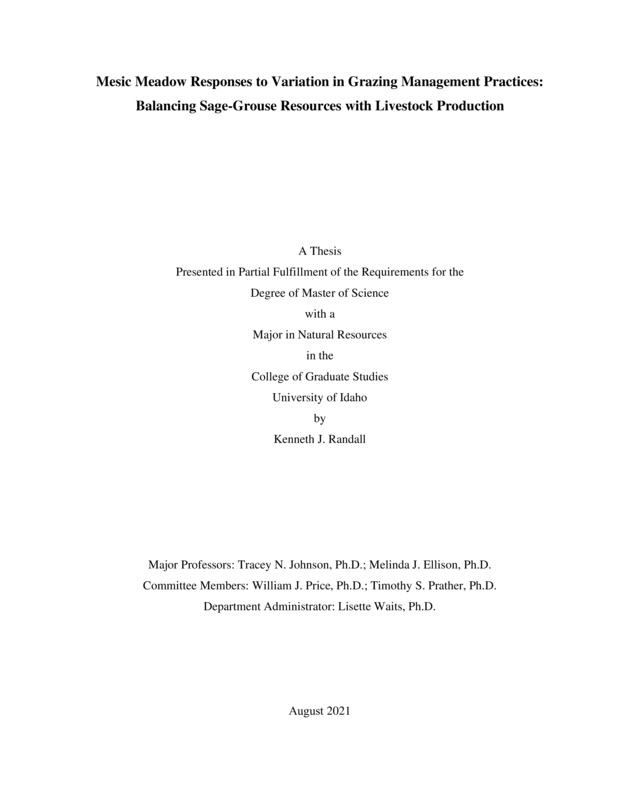Mesic Meadow Responses to Variation in Grazing Management Practices: Balancing Sage-Grouse Resources with Livestock Production
Randall, Kenneth John. (2021-08). Mesic Meadow Responses to Variation in Grazing Management Practices: Balancing Sage-Grouse Resources with Livestock Production. Theses and Dissertations Collection, University of Idaho Library Digital Collections. https://www.lib.uidaho.edu/digital/etd/items/randall_idaho_0089n_12200.html
- Title:
- Mesic Meadow Responses to Variation in Grazing Management Practices: Balancing Sage-Grouse Resources with Livestock Production
- Author:
- Randall, Kenneth John
- Date:
- 2021-08
- Keywords:
- forage forbs greater sage-grouse livestock grazing riparian wildlife habitat
- Program:
- Natural Resources
- Subject Category:
- Natural resource management; Wildlife management; Range management
- Abstract:
-
Mesic meadows across the arid western United States play an integral role in providing water and forage resources for wildlife and domesticated livestock. Greater sage-grouse (Centrocercus urophasianus; hereafter, sage-grouse), a species of conservation concern, depend upon mesic meadows because they support key forb species of high nutritional importance to juveniles during late-brood rearing. Additionally, mesic meadows provide valuable forage and water resources to domesticated livestock, especially as summer progresses and adjacent upland vegetation begins to desiccate. Due to the limited geographic extent (< 3%) of mesic systems at the landscape scale, identifying management techniques that provide grazing opportunity and balance the resource needs of greater sage-grouse is essential. Thus, the first chapter of this thesis sought to evaluate how variation in the season (Early: early-June Late: early-August) and intensity (Control: 0%, Moderate: 30-40%, High: 70-80% relative use) of short-duration livestock grazing in mesic meadows influence cover and biomass percentages of sage-grouse high importance forbs (HIF), pre-grazing to post-grazing change in soil moisture, and noxious weed cover immediately before and after grazing and following a rest period for pasture regrowth. Neither short-duration grazing treatments nor ungrazed control treatments resulted in a decline in HIF cover of biomass percentages. Alternatively, both early-season and high-intensity grazing treatments independently increased HIF cover during pre-grazing sample periods from 2019 to 2020. We did not detect any changes in HIF metrics during the post-grazing sample period. Again, HIF metrics remained similar within treatments between years during the regrowth sampling period; however, the regrowth percent of biomass comprised of HIF was greater in early-season treatments than late-season treatments in 2020. Pre-grazing to regrowth sampling declines in soil moisture were greater in 2019 than 2020, and early-season grazing treatments experienced larger declines in soil moisture than late-season grazing treatments. Noxious weed cover did not change in response to short-duration grazing or ungrazed control treatments. The second chapter of this thesis evaluated the effects of grazing season and intensity from a livestock performance and forage availability and quality perspective. Early-season grazing improved crude protein (CP) and decreased acid detergent fiber (ADF) and neutral detergent fiber (NDF) from 2019 to 2020. Compared to all other treatments, early-season grazing at a high-intensity produced forages with the greatest CP and lowest NDF during regrowth sampling in late September. Average daily gains (ADG) of yearling heifers varied by year, but variation was minimal and not associated with grazing season or intensity. Differences in forage and ADG responses depended upon year, likely due to greater spring and annual precipitation in 2019 compared to 2020. Developing feasible grazing management strategies that can sustain or enhance mesic resources relied upon by sage-grouse is vital to the conservation of the species. Further, balancing forage quantity and quality responses and livestock performance is essential for the management of mesic systems that support livestock and wildlife. This study provides evidence for the use of grazing as a tool to help achieve wildlife, forage, and livestock management objectives in mesic meadows.
- Description:
- masters, M.S., Natural Resources -- University of Idaho - College of Graduate Studies, 2021-08
- Major Professor:
- Johnson, Tracey N; Ellison, Melinda J
- Committee:
- Price, William J; Prather, Timothy S
- Defense Date:
- 2021-08
- Identifier:
- Randall_idaho_0089N_12200
- Type:
- Text
- Format Original:
- Format:
- application/pdf
- Rights:
- In Copyright - Educational Use Permitted. For more information, please contact University of Idaho Library Special Collections and Archives Department at libspec@uidaho.edu.
- Standardized Rights:
- http://rightsstatements.org/vocab/InC-EDU/1.0/

